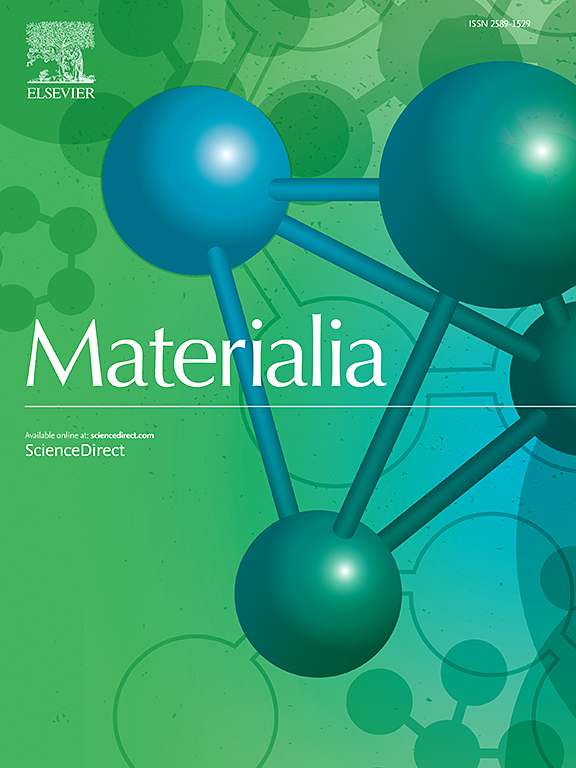Advanced BioS ceramics with integrated optical thermometry for smart scaffolds
IF 2.9
Q2 MATERIALS SCIENCE, MULTIDISCIPLINARY
引用次数: 0
Abstract
This study reports the development of a smart scaffold with photothermal properties designed for 3D tissue engineering platforms. BioS scaffolds were fabricated via 3D printing (NS), sintered (S), and analyzed to assess the incorporation and behavior of Egyptian blue (EB) powder within a ceramic matrix. X-ray diffraction (XRD) confirmed the successful synthesis of EB. The EB powder was thoroughly characterized for its photothermal properties, exhibiting strong optical absorption and photoluminescence, making it a promising candidate for optical thermometry. Fourier transform infrared spectroscopy (FTIR) revealed structural differences between NS- and S-scaffolds following 3D printing. High-temperature sintering of BioS ceramic paste with EB densified the material and potentially induced phase transformations. Micro-computed tomography (µCT) analysis of grain size distribution indicated structural modifications between NS- and S-scaffolds. XRD identified calcium and sodium silicate as the predominant phases, with shifts in EB diffraction peaks after sintering. Scanning electron microscopy (SEM) revealed significant surface morphology changes, corroborating the µCT and XRD findings. The near-infrared (NIR) emission band of EB was utilized to develop a novel strategy for a ratiometric fluorescence thermometer based on a single emission band (2B2g→2B1 g). The EB powder exhibited a maximum relative sensitivity of 0.45% K-1 at 293 K, while the NS- and S-scaffolds demonstrated sensitivities of 0.39% K-1 and 0.30% K-1, respectively. Hemolysis assays confirmed the hemocompatibility of the scaffolds, with red blood cell lysis below 1%. These findings support the safe application of these smart scaffolds in cell culture and biomedical research. Overall, this study provides new insights into developing a more physiologically relevant environment for in vitro cell culture assays by demonstrating the feasibility of integrating photoluminescent and thermosensitive properties– key features of smart materials–into biocompatible ceramic scaffolds. This approach advances the potential for real-time, in vitro monitoring and evaluation in biomedical applications.

用于智能支架的集成光学测温的先进BioS陶瓷
本研究报告了一种为3D组织工程平台设计的具有光热特性的智能支架的开发。通过3D打印(NS)制作BioS支架,烧结(S),并分析埃及蓝(EB)粉末在陶瓷基体中的掺入和行为。x射线衍射(XRD)证实了EB的成功合成。EB粉末具有较强的光吸收和光致发光特性,是光学测温的理想材料。傅里叶变换红外光谱(FTIR)揭示了3D打印后NS-和s -支架的结构差异。用EB对BioS陶瓷浆料进行高温烧结,使材料致密化,并可能诱发相变。微计算机断层扫描(µCT)粒度分布分析表明NS-和s -支架之间的结构改变。XRD鉴定为主要相为钙和硅酸钠,烧结后EB衍射峰发生位移。扫描电镜(SEM)显示了明显的表面形貌变化,证实了微CT和XRD的发现。利用EB的近红外(NIR)发射波段(2B2g→2B1 g)建立了基于单一发射波段(2B2g→2B1 g)的比例荧光温度计的新策略。EB粉末在293 K下的最大相对灵敏度为0.45% K-1,而NS-和s -支架的灵敏度分别为0.39% K-1和0.30% K-1。溶血试验证实了支架的血液相容性,红细胞溶解低于1%。这些发现支持了这些智能支架在细胞培养和生物医学研究中的安全应用。总的来说,这项研究通过展示将光致发光和热敏特性(智能材料的关键特征)整合到生物相容性陶瓷支架中的可行性,为开发更生理相关的体外细胞培养分析环境提供了新的见解。这种方法提高了生物医学应用中实时、体外监测和评估的潜力。
本文章由计算机程序翻译,如有差异,请以英文原文为准。
求助全文
约1分钟内获得全文
求助全文
来源期刊

Materialia
MATERIALS SCIENCE, MULTIDISCIPLINARY-
CiteScore
6.40
自引率
2.90%
发文量
345
审稿时长
36 days
期刊介绍:
Materialia is a multidisciplinary journal of materials science and engineering that publishes original peer-reviewed research articles. Articles in Materialia advance the understanding of the relationship between processing, structure, property, and function of materials.
Materialia publishes full-length research articles, review articles, and letters (short communications). In addition to receiving direct submissions, Materialia also accepts transfers from Acta Materialia, Inc. partner journals. Materialia offers authors the choice to publish on an open access model (with author fee), or on a subscription model (with no author fee).
 求助内容:
求助内容: 应助结果提醒方式:
应助结果提醒方式:


